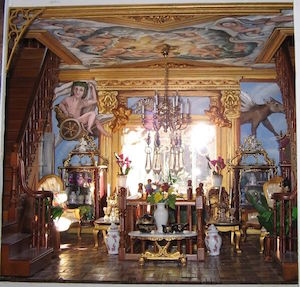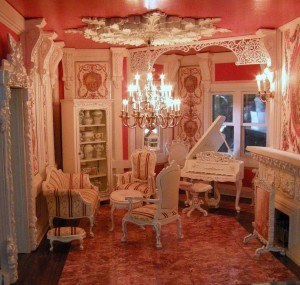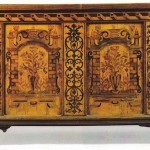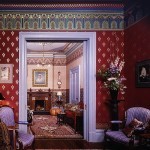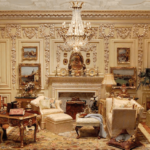Baroque architects took cues from theater design. Just as on a stage set, Baroque dollhouse interiors can use backdrops to give the illusion of infinite space. Just as in a theater, a proscenium, an archway between the stage and the crowd, delineates separate spaces. The concept of theatrical lighting – shafts of focused light (spotlighting) to create shadows in the ambient light, all played roles in how to address space. There was a return to Gothic elements – windows and elaborate vaulting.
The color palette was rich with dark reds and greens. Gold enhanced accent features and decorated the frames of mirrors and paintings.
Baroque interiors are highly detailed, including intricately carved wood paired with luxurious textiles covering furniture and walls, and for window coverings. These fabrics are often damask, with or without floral patterns.
The ceilings were decorated with images of putti (little boys), while plant motifs could be seen in wall decorations.
Baroque style is also distinguished by bold contrasting colors, as opposed to gold and pastels, more prevalent in rococo.
The interiors featured various complex architectural details: religious frescos, and essential characteristics of Baroque.
As befitting church doctrine, the rules of symmetry were critical. This was exemplified in scrollwork, where the letters S and C were favorite subjects. When facing each other, the C-shaped scrolls of the Baroque would line up precisely. In rococo, those scrolls would be askew, breaking the rules, and offering a feeling of whimsicality. Other favorite scrollwork objects were foliage, with and without fruit.
Design Elements
Foliage motifs – A profusion of plant life characterizes the Baroque style.
Initials and monograms, as well as crests
Scrolling foliage and garlands of flowers decorate many objects.
Marquetry – Marquetry is the laying of veneers of different-colored woods onto the surface of furniture. French and Dutch cabinet-makers taught this novel form of decoration.
Putti – The Italian word ‘putti’ means ‘boys,’ and emphasizes the desire to have chubby, well-fed infants on earth, as well as heaven.
Crests and initials – The decorative use of monograms, usually people’s initials, was a particular feature of the Baroque style. Heraldic crests incorporated into designs gave the status and ownership of the symbol.
Lambrequin motif – Baroque interiors were enriched with luxurious textiles. The lambrequin, or tasseled cloth motif, is one of the most common.
Floors are typically made from high-end materials such as solid wood or marble. Large room-sized, hand-woven rugs are placed to soften spaces
Furniture is intricately detailed to accent embellishments with carvings on curved legs. Gold gilding on frames, statues, and pottery are common. Large mirrors, crystal chandeliers, doorknobs, and pulls are used extensively.
Luxury fabrics in damask and floral prints are used for upholstery, wall coverings, and floor-to-ceiling window coverings.
The Baroque style lasted until about 1726, when the asymmetrical Rococo style began to evolve.
Patrick Owens



